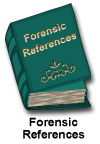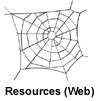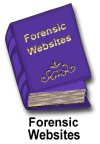|
|
 |
The
required readings for this unit are:
Unit.C.4.3.
Family/Crisis Intervention/ Psychosocial
 Australia
Australia |
Required
Reading(s)
|
 |
Insert article
here
 Canada
Canada |
Required
Reading(s)
|
 |
Kent-Wilkinson,
A. (1999). Forensic family genogram: An assessment &
intervention tool. Journal of Psychosocial Nursing, 37
(9), 52-56.
- Note this
forensic assessment tool to assist in the recognition
of patterns of illness and behaviors in families.
 International
International |
Required
Reading(s)
|
 |
Sweden
Rask, M., & Levander, S. (2001). Interventions in
the nurse-patient relationship in forensic psychiatric
nursing care: A Swedish survey. Journal of Psychiatric
& Mental Health Nursing, 8(4), 323-333. Retrieved
December 12, 2002, from Academic Search Premier database:
http://search.epnet.com/direct.asp?an=4862208&db=aph
- Note:
Nurses (Registered nurses, RN, and Licensed Mental
Nurses, LMN) working in five Swedish forensic
psychiatric units filled in a questionnaire
designed for general psychiatric nursing,
but modified for forensic use. In
this report, data concerning the extent to which
treatment interventions included verbal elements,
and the focus of these nurse-patient verbal interactions,
were analysed. The most commonly used interventions
were 'social interaction', 'regular communication'
and 'social skills training'. The most common focus
in verbal nurse-patient interaction were 'explaining
consequences, confronting and encouraging the patient
to talk about his/her crime/behaviour', 'interpretative
communications with the patient', and 'communication
about functions in daily life'. The salient findings
were: (1) seven of the fifteen interventions used
by the nurses included verbal elements to a great
extent; (2) nurses often used confronting interventions,
despite the fact that the large EE (expressed emotion)
literature suggest that hostility and critical remarks
may provoke a worsening of symptoms among psychotic
patients; (3) there was only little correspondence
between actual practice and theoretical models;
and (4) there were unexpectedly small differences
between the two professional groups (RN and LMN),
suggesting that the roles are not distinct.
|
 United Kingdom
United Kingdom |
Required
Reading(s)
|
 |
Mason, T.,
Richman, J., & Mercer, D. (2002). The influence
of evil on forensic clinical practice. International
Journal of Mental Health Nursing, 11(2), 80-93.
Retrieved December 19, 2002, from EPSCO Database -Academic
Search Premier:
http://search.epnet.com/direct.asp?an=7658208&db=aph
- Explores
the influence of evil on forensic clinical practice
in a psychiatric hospital in England. Examination
of the construction of care plans; Switch from medical
ideological discourse to lay notions of badness;
Development of an Airaksinen model to display types
of evil manifestations.
Minden, P. (2002). Humor as the focal point of treatment
for forensic psychiatric patients. Holistic Nursing
Practice, 16(4), 75-86. Retrieved December 16,
2002, from Academic Search Premier database:
http://search.epnet.com/direct.asp?an=6712624&db=aph
- Minden
evaluates the Humor Group, a unique treatment modality
evoking therapeutic change by engaging male forensic
psychiatric patients and nursing students in humorous
activities. The Humor Group structure and format
are offered as guides for undertaking similar attempts
to rein in humor's healing potential in other settings
and with other populations.
|
 United States
United States |
Required
Reading(s)
|
 |
Insert article
here
Databases
For the full text article online,
sleuth the 'University
of Calgary/ Library/ Article Indexes':
Directions:
- Select
- Indexes and abstracts with links to full text articles
- Select
- Academic Search Premier or Expanded Academic ASAP
- Select
- Connect
-
Fill in
User ID and Pin
- Fill
in search words:
- forensic*
and debriefing
- forensic*
and therapeutic
Top of Page
|
 |
 |
The
'recommended only' readings for this unit are the following:
Unit.C.4.3.
Family/Crisis Intervention/ Psychosocial
 Australia
Australia |
Recommended
Reading(s)
|
 |
Insert article/book/chapter
here
 Canada
Canada |
Recommended
Reading(s)
|
 |
Peternelj-Taylor,
C. (2002). Professional boundaries: A matter of therapeutic
integrity. Journal of
Psychosocial Nursing & Mental Health Services, 40(4),
22-29. Retrieved July 2, 2002, from ProQuest database.
Silversides, A. (2001). Lessons Canada learned in
Swissair crash being applied in New York
Canadian Medical Association Journal, 165(9),
1243. Retrieved July 2, 2002, from ProQuest database.
- The
1998 Swissair crash in Nova Scotia gave Canadians
the expertise needed to help relatives of those
killed in the terrorist assaults on the World Trade
Center, and within days of those Sept. 11 attacks
that expertise was on its way to New York City.
- "Two
lessons we learned from Swissair were the need to
get the right information to families and to work
with families," Dr. James Young, Ontario's
chief coroner, said in a telephone interview from
New York at the end of September.
|
 International
International |
Recommended
Reading(s)
|
 |
Insert article/book/chapter
here
 United Kingdom
United Kingdom |
Recommended
Reading(s)
|
 |
McCann, G., Mckeown,
M. & Porter, I. (1995). Identifying the needs of relatives
of forensic patients. Nursing Times, 91 (24), 35-37.
- Note - the
focus is on evaluating the needs of relatives of forensic
patients, in particular, the problems resulting from the
offence and a diagnosis of schizophrenia (McCann, McKeown
& Porter (1995, p. 25).
 United States
United States |
Recommended
Reading(s)
|
 |
Unit.C.4.3.
Family/Crisis Intervention/ Psychosocial
|
Clements, P. T., & Burgess, A. W. (2002). Children's
responses to family member homicide. Family and
Community Health, 25, (1), 32-42. Retrieved July
2, 2002, from ProQuest database.
- Homicide
is a significant behavioral deviation resulting
in a sudden and unexpected loss of life and can
leave children in the chaotic wake. Interviews conducted
with 13 children ages 9 to 11 years during the initial
1 to 3 months after a family homicide provided insight
into themes of bereavement.
- A major
finding in the study was that the witnessing or
hearing the news of a family member homicide was
a powerful associative factor for childhood posttraumatic
stress disorder (PTSD) and for complicated bereavement.
- Murder
of a family member leaves more than just bodies
behind. Murder leaves survivors to struggle and
cope with sudden and violent loss of life.
- Of interest
to family and community health practitioners are
the mental health consequences for those youth exposed
to bereavement after the inherently traumatic homicide
of a family member.
Deranieri,
J. T., Clements, P. T., & Henry, G. C. (2002).
When catastrophe happens: Assessment and intervention
after sudden traumatic death. Journal of Psychosocial
Nursing & Mental Health Services, 40(4), 30-40.
Retrieved July 28, 2002, from ProQuest database.
- When
a family member, friend, or colleague dies as the
result of a sudden traumatic death, it can be perceived
as a catastrophic event. The effect of the death
may result in significant disruption to the structure,
function, and reorganization of those struggling
to adapt to the sudden loss. Attempts at homeostasis
and functional grieving may be interrupted by complicating
issues related to the dynamics of sudden traumatic
death and can be affected by current problem-solving
skills and methods of coping employed by the surviving
individuals.
McClain,
M. E., & Shaefer, S.J.M. (1996). Supporting families
after sudden infant death. Journal of Psychosocial
Nursing and Mental Health Services, 34 (4), 30-34.
- Note
the strategies for family support.
Minden,
P. (2002). Humor as the focal point of treatment for
forensic psychiatric patients.Holistic Nursing
Practice, 16(4), 75-86. Academic Search Premier
database :
http://search.epnet.com/direct.asp?an=6712624&db=aph
- Minden
evaluates the Humor Group, a unique treatment modality
evoking therapeutic change by engaging male forensic
psychiatric patients and nursing students in humorous
activities. The Humor Group structure and format
are offered as guides for undertaking similar attempts
to rein in humor's healing potential in other settings
and with other populations.
O'Connor,
S., & Gervasini, A. (2001). Trauma death of a
28-year-old: Two clinicians help a family to view
the body and keep a lock of hair. Journal of Emergency
Nursing, 27(2), 159-161
|
Top of Page
|

|
Additional
references for this unit can be found in 'forensic
references'
of the forensic sourcebooks.
- Sleuth
'forensic reference' database for:
forensic - family
Top of Page
|

|
Video's
recommended for this unit are:
|
|
Resources
(Video)
|
 |
Peternelj-Taylor,
C.A. (1993). [Video] Psychiatric nursing practice in
corrections [Video]. (22.17 minutes) Saskatoon, Saskatchewan,
University of Saskatchewan, Division of Audio Visual Services.
·
- Note the key
concepts of building a trusting relationship, self awareness,
and therapeutic relationships.
Top of Page
|

|
The
required websites to sleuth for this unit are the following:
 Australia
Australia |
Resources
(Web)
|
 |
Insert website
here
 Canada
Canada |
Resources
(Web)
|
 |
Butt, J. (2002).
Swiss Air Tragedy - Family Crisis - Major Disasters. Retrieved
may 16, 2002 from Pathfinder Forum: http://www.pathfinderforum.com/majordisasters/index.htm
- Note the
links to the Swiss Air Tragedy on Sept 2, 1998 and the
role of health care professionals with the grieving families
during this disaster.
Kent-Wilkinson,
A. (2002) Forensic Family Genogram. Retrieved June 15, 2002
from Forensic education Website: http://www.forensiceducation.com/forensic_files/genogram.htm
- Note the
patterns that become evident by plotting the key demographic
and health during the forensic family history.
 International
International |
Resources
(Web)
|
 |
Insert website
here
 United Kingdom
United Kingdom |
Resources
(Web)
|
 |
Insert website
here
 United States
United States
|
Resources
(Web)
|
 |
Insert article
here
Top of Page
|
 |
For
additional websites on this unit, sleuth 'forensic
websites' in the forensic sourcebooks.
Top of Page
|
 |
|